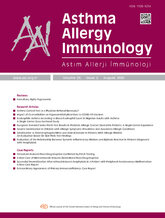


Objective: Biphasic anaphylaxis, defined as the recurrence of symptoms after initial resolution without re-exposure to the trigger, remains a significant clinical challenge. Identifying laboratory-based predictors of biphasic reactions may help optimize monitoring and management strategies. This study aimed to investigate the relationship between systemic inflammatory markers—neutrophil-tolymphocyte ratio (NLR), platelet-to-lymphocyte ratio (PLR), systemic inflammation index (SII), systemic inflammatory response index (SIRI), and pan-immune-inflammation value (PIV)—and the development of biphasic reactions in adult patients presenting to the emergency department with anaphylaxis.
Materials and Methods: This retrospective observational study included adult patients diagnosed with anaphylaxis between January 1, 2024, and January 1, 2025, at the emergency department of a tertiary care hospital. Demographic data, clinical findings, laboratory values at presentation, and outcomes were collected. Biphasic reactions were defined as a recurrence of symptoms between 1 and 72 hours after initial improvement. Inflammatory markers were calculated from initial complete blood counts and compared between patients with and without biphasic reactions.
Results: A total of 142 patients were included, of whom 14 (9.9%) experienced biphasic reactions. There were no statistically significant differences in NLR, PLR, SII, SIRI, or PIV between the biphasic and non-biphasic groups (p > 0.05 for all). Hypotension was observed more frequently in the biphasic group, but the difference did not reach statistical significance (p = 0.059).
Conclusion: Systemic inflammatory markers derived from admission laboratory values were not significantly associated with the development of biphasic anaphylactic reactions. Further prospective studies are warranted to identify reliable biomarkers for early prediction and risk stratification.